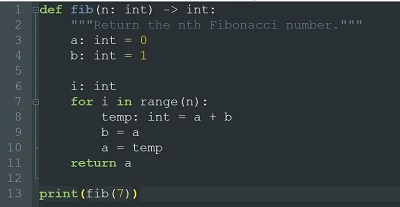Most exam boards offering Computer Science GCSE and A Level courses allow students a choice of which programming language to use. This usually includes Python along with other options like Java, C# or Visual Basic.
In some ways Python is less strict than the others, and this can cause problems for students. For example in Python, there is no need to specify the type of variables, including function arguments. There is also no need to specify the return type from a function. However these details are expected by examiners. Compare the following code snippets:
Python
def fib(n):
a = 0
b = 1
for i in range(n):
temp = a + b
b = a
a = temp
return a
C#
public static int Fibonacci(int n)
{
int a = 0;
int b = 1;
for (int i = 0; i < n; i++)
{
int temp = a + b;
b = a;
a = temp;
}
return a;
}
You can see that the Python version has a lot less information about data types. One solution to giving the examiner what they want when writing program code solutions to questions in Python is to use comments to explicitly name the type of a variable. However, with Python 3’s type annotations there is a better way. Take a look a this code:
def fib(n: int) -> int:
a: int = 0
b: int = 1
i: int
for i in range(n):
temp: int = a + b
b = a
a = temp
return a
Can you see how the type hints are now built into the code like in other languages? There is one detail that you may have noticed – since you can’t use :
